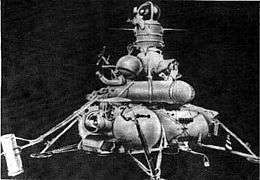Luna 20
 Luna 20 | |
| Mission type | Lunar sample return |
|---|---|
| COSPAR ID | 1972-007A |
| SATCAT № | 5835 |
| Spacecraft properties | |
| Bus | Ye-8-5 |
| Manufacturer | GSMZ Lavochkin |
| Launch mass | 5,727 kilograms (12,626 lb) |
| Dry mass | 5,600 kilograms (12,300 lb) |
| Start of mission | |
| Launch date | February 14, 1972, 03:27:59 UTC |
| Rocket | Proton-K/D |
| Launch site | Baikonur 81/24 |
| End of mission | |
| Landing date | February 25, 1972, 19:19 UTC |
| Landing site | 40 km north of Dzhezkazgan, Kazakhstan |
| Orbital parameters | |
| Reference system | Selenocentric |
| Semi-major axis | 6,477.8 kilometres (4,025.1 mi) |
| Eccentricity | 0.0 |
| Periselene | 100 kilometres (62 mi) |
| Aposelene | 100 kilometres (62 mi) |
| Inclination | 65 degrees |
| Period | 119 minutes |
| Lunar orbiter | |
| Orbits | ~36 |
| Lunar lander | |
| Landing date |
February 21, 1972, 19:19 UTC |
| Return launch |
February 22, 1972, 22:58 UTC |
| Landing site | 3°32′N 56°33′E / 3.533°N 56.550°E |
| Sample mass | 30 grams |
Luna 20 was the second of three successful Soviet lunar sample return missions. It was flown as part of the Luna program as a robotic competitor to the six successful Apollo lunar sample return missions. Luna 20 was placed in an intermediate Earth parking orbit and from this orbit was sent towards the Moon. It entered lunar orbit on February 18, 1972. On February 21, 1972, Luna 20 soft landed on the Moon in a mountainous area known as the Terra Apollonius (or Apollonius highlands) near Mare Fecunditatis (Sea of Fertility), 120 km from where Luna 16 had landed. While on the lunar surface, the panoramic television system was operated. Lunar samples were obtained by means of an extendable drilling apparatus. The ascent stage of Luna 20 was launched from the lunar surface on 22 February 1972 carrying 30 grams of collected lunar samples in a sealed capsule.[1] It landed in the Soviet Union on 25 February 1972. The lunar samples were recovered the following day.
This was the eighth Soviet spacecraft launched with the intent of returning lunar soil to Earth. It was evidently sent to complete the mission that Luna 18 had failed to accomplish. After a 4.5-day flight to the Moon, which included a single midcourse correction on 15 February, Luna 20 entered orbit around the Moon on 18 February. Initial orbital parameters were 100 x 100 kilometers at 65° inclination. Three days later, at 19:13 UT, the spacecraft fired its main engine for 267 seconds to begin descent to the lunar surface. A second firing further reduced velocity before Luna 20 set down safely on the Moon at 19:19 UT on 21 February 1972 at coordinates 3°32' north latitude and 56°33' east longitude, only 1.8 kilometers from the crash site of Luna 18. After collecting a small sample of lunar soil, the spacecraft’s ascent stage lifted off at 22:58 UT on 22 February and quickly accelerated to 2.7 kilometers per second velocity—sufficient to return to Earth. The small spherical capsule eventually parachuted down safely on an island in the Karkingir River, 40 kilometers north of the town of Jezkazgan in Kazakhstan, at 19:19 UT on 25 February 1972.
The 30-gram soil sample differed from that collected by Luna 16 in that the majority (50 to 60%) of the rock particles in the newer sample were ancient lunar highlands anorthosite (which consists largely of feldspar) rather than the basalt of the earlier one (which contained about 1 to 2% of anorthosite). The American Apollo 16 mission returned similar highlands material two months later. Like the Luna 16 soil, samples of the Luna 20 collection were shared with American and French scientists.
| Lunar Mission | Sample Returned | Year |
|---|---|---|
| Luna 16 | 101 g[2] | 1970 |
| Luna 20 | 30 g[1] | 1972 |
| Luna 24 | 170.1 g[3] | 1976 |
In March 2010, NASA reported that the Lunar Reconnaissance Orbiter had spotted the Luna 20.[4]
See also
References
- 1 2 "NASA - NSSDC - Spacecraft - Details". nssdc.gsfc.nasa.gov. Retrieved 2015-11-08.
- ↑ "NASA - NSSDC - Spacecraft - Details". nssdc.gsfc.nasa.gov. Retrieved 2015-11-08.
- ↑ "NASA - NSSDC - Spacecraft - Details". nssdc.gsfc.nasa.gov. Retrieved 2015-11-08.
- ↑ David, Leonard (2010-03-18). "NASA Lunar Orbiter Spots Old Soviet Moon Landers".

